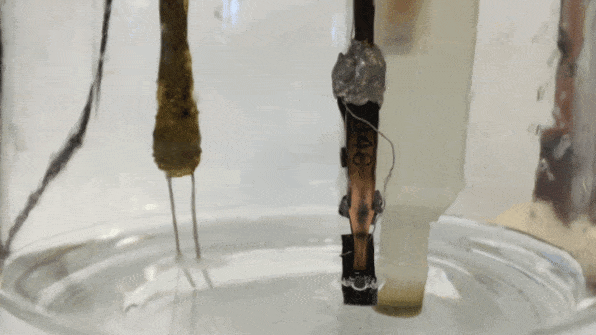If you want to buy an electric car in the U.S., there are more than a dozen options. If you want to buy a fuel cell car, there are three: the Honda Clarity, the Toyota Mirai, and the Hyundai ix35. But more are coming–and a new discovery in the lab might help the market expand faster.
Fuel cell cars run on hydrogen, and making hydrogen is a challenge. The traditional method of producing hydrogen (which is now typically sold to manufacturers for everything from refining metal to making margarine) starts with fossil fuels. If you heat up coal or natural gas you get hydrogen–but you also get carbon pollution. As an alternative, it’s possible to make hydrogen from water by splitting water molecules with electrolysis. It’s a clean process that produces zero pollution, but it also takes a lot of energy, and the resulting hydrogen is expensive. Catalysts like platinum can speed up the reaction and help save energy but are also expensive.

Physicists at the University of Houston have discovered a way to make the process more efficient for little cost. Their catalyst, made from cheap nickel instead of the pricey precious metals used today, helps one part of the reaction happen more easily. And if it is eventually used in production, it could mean hydrogen fuel that costs significantly less than it does today.
The cost of fuel is one of the hurdles for the technology. “Ultimately, the cost of delivered retail hydrogen is a big challenge,” says Mark Duvall, director of energy utilization at the Electric Power Research Institute, a nonprofit that has studied the technology in detail. The average cost at the tank in April 2017–from one small sample of fueling stations–was $14.10 per gallon of gasoline equivalent.
That cost for consumers also depends on factors beyond production, such as compressing the gas, transporting it, and the cost of building new stations. But if the new catalyst is used to make hydrogen from water, after more development, it could eventually help bring the cost of making it down to the level of making hydrogen from fossil fuels, and lower the total cost at the pump.

“Basically, this whole process is about finding new, cheap catalysts for an environmentally friendly process to produce hydrogen from water,” says Zhifeng Ren, a physics professor at the University of Houston and one of the authors of a new paper about the technology.
In general, fuel cell cars are less efficient than battery electric cars. If you use a solar panel to charge a battery, the process is roughly 85% efficient. Using a fuel cell takes more steps–electrolysis, compressing the gas, and then running the hydrogen in the fuel cell–each of which makes the system less efficient (roughly 30-40% efficient), and more expensive. The new way of making fuel could help, though other aspects of the technology will also have to improve to make fuel cells competitive with electric cars.
“New catalysts are great,” says Sally Benson, co-director of the Precourt Institute for Energy at Stanford University. “But if you look at light-duty transport, I would be seriously skeptical that it would be sufficient to switch to making fuel cell vehicles more desirable than battery electric vehicles.”
There are several challenges to overcome, including the cost of manufacturing the cars themselves. “I have a little difficulty seeing as how hydrogen fuel cell vehicles get to be less expensive than electric vehicles, given that a fuel cell vehicle is basically an electric vehicle,” says Duvall. “Except that instead of a large battery it has a small high-power battery like you’d find in a hybrid vehicle. It is an electric vehicle with some extra complexities.”
The infrastructure for fuel cell vehicles also still has to be built. If you own a fuel cell car in the Bay Area or Los Angeles, there are places to fuel up–but the stations are rare elsewhere.

Still, Duvall believes that fuel cell cars could be coming at a larger scale (as do car manufacturers, many of whom have new fuel cell models in development along with electric cars, though Elon Musk has notably called them “mind-bogglingly stupid.”) “I consider both technologies to be ultimately feasible,” Duvall says. “I just consider them to be in different stages of development.”
Fuel cell cars have one significant advantage: fueling them is fast, unlike charging an electric car. A Toyota Mirai with a quarter-tank of hydrogen takes a little over six minutes to fill up, only a little longer than a gas car. The technology may be especially attractive for trucks traveling long distances when charging batteries would be impractical.
“I’m cautiously optimistic that the technical challenges will be met,” Duvall says. “There’s a lot of very good people and a lot of companies really working on this.” The researchers at the University of Houston may provide one piece of the solution in helping the technology scale.
“I’m planning to set up large-scale testing, and if it’s successful, we’re looking to have a small-scale startup company to make hydrogen using this technology that we’ve developed,” says Ren.
A discovery of a new catalyst to separate hydrogen from water changes the math on a hydrogen-powered future–but that math is still not good enough.
If you want to buy an electric car in the U.S., there are more than a dozen options. If you want to buy a fuel cell car, there are three: the Honda Clarity, the Toyota Mirai, and the Hyundai ix35. But more are coming–and a new discovery in the lab might help the market expand faster.
Fast Company , Read Full Story
(32)